EO Exploitation Platform Common Architecture
Master System Interface Control Document
EOEPCA.ICD.001
COMMENTS and ISSUES |
PDF |
EUROPEAN SPACE AGENCY CONTRACT REPORT |
TELESPAZIO VEGA UK Ltd |
- AMENDMENT HISTORY
-
This document shall be amended by releasing a new edition of the document in its entirety.
The Amendment Record Sheet below records the history and issue status of this document.Table 1. Amendment Record Sheet ISSUE
DATE
REASON
0.1
dd/mm/yyyy
In-progress draft
1. Introduction
1.1. Purpose and Scope
This is the Master System Interface Control Document for the Common Architecture.
1.2. Structure of the Document
- Section 2 - [mainContext]
-
Provides the context for Exploitation Platforms within the ecosystem of EO analysis.
- Section 3 - [mainDesignOverview]
-
Provides an overview of the Common Architecture and the domain areas.
- Section 4 - User Management
-
Describes the User Management domain area.
- Section 5 - Processing & Chaining
-
Describes the Processing & Chaining domain area.
- Section 6 - Resource Management
-
Describes the Resource Management domain area.
- Section 7 - [mainPlatformApi]
-
Describes the Platform API, covering all domain areas.
- Section 8 - [mainWebPortal]
-
Describes the Web Portal, covering all domain areas.
1.3. Reference Documents
The following is a list of Reference Documents with a direct bearing on the content of this document.
| Reference | Document Details | Version |
|---|---|---|
EOEPCA - Master System Design Document |
Issue 1.0, |
|
EOEPCA - Use Case Analysis |
Issue 1.0, |
|
Exploitation Platform - Functional Model, |
Issue 1.0, |
|
Thematic Exploitation Platform Open Architecture, |
Issue 1, |
|
OGC Web Processing Service, |
05-007r7, |
|
OGC® WPS 2.0 Interface Standard, |
14-065r2, |
|
OGC WPS 2.0 REST/JSON Binding Extension, Draft, |
1.0-draft.4 |
|
OGC Web Services Common Standard, |
06-121r9 v2.0.0, |
|
Common Workflow Language Specifications, |
v1.0.2 |
|
OGC Testbed-13, EP Application Package Engineering Report, |
17-023, |
|
OGC Testbed-13, Application Deployment and Execution Service Engineering Report, |
17-024, |
|
OGC Testbed-14, Application Package Engineering Report, |
18-049r1, |
|
OGC Testbed-14, ADES & EMS Results and Best Practices Engineering Report, |
18-050r1, |
|
OpenSearch GEO: OpenSearch Geo and Time Extensions, |
10-032r8, |
|
OpenSearch EO: OGC OpenSearch Extension for Earth Observation, |
13-026r9, |
|
OGC EO Dataset Metadata GeoJSON(-LD) Encoding Standard, |
17-003r1/17-084 |
|
OGC OpenSearch-EO GeoJSON(-LD) Response Encoding Standard, |
17-047 |
|
The Payment Card Industry Data Security Standard, |
v3.2.1 |
|
CEOS OpenSearch Best Practise, |
v1.2, |
|
OpenID Connect Core 1.0, |
v1.0, |
|
OGC Catalogue Services 3.0 Specification - HTTP Protocol Binding (Catalogue Services for the Web), |
v3.0, |
|
OGC Web Map Server Implementation Specification, |
v1.3.0, |
|
OGC Web Map Tile Service Implementation Standard, |
v1.0.0, |
|
OGC Web Feature Service 2.0 Interface Standard – With Corrigendum, |
v2.0.2, |
|
OGC Web Coverage Service (WCS) 2.1 Interface Standard - Core, |
v2.1, |
|
Web Coverage Processing Service (WCPS) Language Interface Standard, |
v1.0.0, |
|
Amazon Simple Storage Service REST API, |
API Version 2006-03-01 |
|
SpatioTemporal Asset Catalog specification, |
1.0.0-beta.2 |
|
SpatioTemporal Asset Catalog API specification, |
1.0-beta |
1.4. Terminology
The following terms are used in the Master System Interface Control Document.
| Term | Meaning |
|---|---|
Admin |
User with administrative capability on the EP |
Algorithm |
A self-contained set of operations to be performed, typically to achieve a desired data manipulation. The algorithm must be implemented (codified) for deployment and execution on the platform. |
Analysis Result |
The Products produced as output of an Interactive Application analysis session. |
Analytics |
A set of activities aimed to discover, interpret and communicate meaningful patters within the data. Analytics considered here are performed manually (or in a semi-automatic way) on-line with the aid of Interactive Applications. |
Application Artefact |
The 'software' component that provides the execution unit of the Application Package. |
Application Deployment and Execution Service (ADES) |
WPS-T (REST/JSON) service that incorporates the Docker execution engine, and is responsible for the execution of the processing service (as a WPS request) within the ‘target’ Exploitation Platform. |
Application Descriptor |
A file that provides the metadata part of the Application Package. Provides all the metadata required to accommodate the processor within the WPS service and make it available for execution. |
Application Package |
A platform independent and self-contained representation of a software item, providing executable, metadata and dependencies such that it can be deployed to and executed within an Exploitation Platform. Comprises the Application Descriptor and the Application Artefact. |
Bulk Processing |
Execution of a Processing Service on large amounts of data specified by AOI and TOI. |
Code |
The codification of an algorithm performed with a given programming language - compiled to Software or directly executed (interpretted) within the platform. |
Compute Platform |
The Platform on which execution occurs (this may differ from the Host or Home platform where federated processing is happening) |
Consumer |
User accessing existing services/products within the EP. Consumers may be scientific/research or commercial, and may or may not be experts of the domain |
Data Access Library |
An abstraction of the interface to the data layer of the resource tier. The library provides bindings for common languages (including python, Javascript) and presents a common object model to the code. |
Development |
The act of building new products/services/applications to be exposed within the platform and made available for users to conduct exploitation activities. Development may be performed inside or outside of the platform. If performed outside, an integration activity will be required to accommodate the developed service so that it is exposed within the platform. |
Discovery |
User finds products/services of interest to them based upon search criteria. |
Execution |
The act to start a Processing Service or an Interactive Application. |
Execution Management Service (EMS) |
The EMS is responsible for the orchestration of workflows, including the possibility of steps running on other (remote) platforms, and the on-demand deployment of processors to local/remote ADES as required. |
Expert |
User developing and integrating added-value to the EP (Scientific Researcher or Service Developer) |
Exploitation Tier |
The Exploitation Tier represents the end-users who exploit the services of the platform to perform analysis, or using high-level applications built-in on top of the platform’s services |
External Application |
An application or script that is developed and executed outside of the Exploitation Platform, but is able to use the data/services of the EP via a programmatic interface (API). |
Guest |
An unregistered User or an unauthenticated Consumer with limited access to the EP’s services |
Home Platform |
The Platform on which a User is based or from which an action was initiated by a User |
Host Platform |
The Platform through which a Resource has been published |
Identity Provider (IdP) |
The source for validating user identity in a federated identity system, (user authentication as a service). |
Interactive Application |
A stand-alone application provided within the exploitation platform for on-line hosted processing. Provides an interactive interface through which the user is able to conduct their analysis of the data, producing Analysis Results as output. Interactive Applications include at least the following types: console application, web application (rich browser interface), remote desktop to a hosted VM. |
Interactive Console Application |
A simple Interactive Application for analysis in which a console interface to a platform-hosted terminal is provided to the user. The console interface can be provided through the user’s browser session or through a remote SSH connection. |
Interactive Remote Desktop |
An Interactive Application for analysis provided as a remote desktop session to an OS-session (or directly to a 'native' application) on the exploitation platform. The user will have access to a number of applications within the hosted OS. The remote desktop session is provided through the user’s web browser. |
Interactive Web Application |
An Interactive Application for analysis provided as a rich user interface through the user’s web browser. |
Key-Value Pair |
A key-value pair (KVP) is an abstract data type that includes a group of key identifiers and a set of associated values. Key-value pairs are frequently used in lookup tables, hash tables and configuration files. |
Kubernetes (K8s) |
Container orchestration system for automating application deployment, scaling and management. |
Login Service |
An encapsulation of Authenticated Login provision within the Exploitation Platform context. The Login Service is an OpenID Connect Provider that is used purely for authentication. It acts as a Relying Party in flows with external IdPs to obtain access to the user’s identity. |
Network of EO Resources |
The coordinated collection of European EO resources (platforms, data sources, etc.). |
Object Store |
A computer data storage architecture that manages data as objects. Each object typically includes the data itself, a variable amount of metadata, and a globally unique identifier. |
On-demand Processing Service |
A Processing Service whose execution is initiated directly by the user on an ad-hoc basis. |
Platform (EP) |
An on-line collection of products, services and tools for exploitation of EO data |
Platform Tier |
The Platform Tier represents the Exploitation Platform and the services it offers to end-users |
Processing |
A set of pre-defined activities that interact to achieve a result. For the exploitation platform, comprises on-line processing to derive data products from input data, conducted by a hosted processing service execution. |
Processing Result |
The Products produced as output of a Processing Service execution. |
Processing Service |
A non-interactive data processing that has a well-defined set of input data types, input parameterisation, producing Processing Results with a well-defined output data type. |
Products |
EO data (commercial and non-commercial) and Value-added products and made available through the EP. It is assumed that the Hosting Environment for the EP makes available an existing supply of EO Data |
Resource |
A entity, such as a Product, Processing Service or Interactive Application, which is of interest to a user, is indexed in a catalogue and can be returned as a single meaningful search result |
Resource Tier |
The Resource Tier represents the hosting infrastructure and provides the EO data, storage and compute upon which the exploitation platform is deployed |
Reusable Research Object |
An encapsulation of some research/analysis that describes all aspects required to reproduce the analysis, including data used, processing performed etc. |
Scientific Researcher |
Expert user with the objective to perform scientific research. Having minimal IT knowledge with no desire to acquire it, they want the effort for the translation of their algorithm into a service/product to be minimised by the platform. |
Service Developer |
Expert user with the objective to provide a performing, stable and reliable service/product. Having deeper IT knowledge or a willingness to acquire it, they require deeper access to the platform IT functionalities for optimisation of their algorithm. |
Software |
The compilation of code into a binary program to be executed within the platform on-line computing environment. |
Systematic Processing Service |
A Processing Service whose execution is initiated automatically (on behalf of a user), either according to a schedule (routine) or triggered by an event (e.g. arrival of new data). |
Terms & Conditions (T&Cs) |
The obligations that the user agrees to abide by in regard of usage of products/services of the platform. T&Cs are set by the provider of each product/service. |
Transactional Web Processing Service (WPS-T) |
Transactional extension to WPS that allows adhoc deployment / undeployment of user-provided processors. |
User |
An individual using the EP, of any type (Admin/Consumer/Expert/Guest) |
Value-added products |
Products generated from processing services of the EP (or external processing) and made available through the EP. This includes products uploaded to the EP by users and published for collaborative consumption |
Visualisation |
To obtain a visual representation of any data/products held within the platform - presented to the user within their web browser session. |
Web Coverage Service (WCS) |
OGC standard that provides an open specification for sharing raster datasets on the web. |
Web Coverage Processing Service (WCPS) |
OGC standard that defines a protocol-independent language for the extraction, processing, and analysis of multi-dimentional coverages representing sensor, image, or statistics data. |
Web Feature Service (WFS) |
OGC standard that makes geographic feature data (vector geospatial datasets) available on the web. |
Web Map Service (WMS) |
OGC standard that provides a simple HTTP interface for requesting geo-registered map images from one or more distributed geospatial databases. |
Web Map Tile Service (WMTS) |
OGC standard that provides a simple HTTP interface for requesting map tiles of spatially referenced data using the images with predefined content, extent, and resolution. |
Web Processing Services (WPS) |
OGC standard that defines how a client can request the execution of a process, and how the output from the process is handled. |
Workspace |
A user-scoped 'container' in the EP, in which each user maintains their own links to resources (products and services) that have been collected by a user during their usage of the EP. The workspace acts as the hub for a user’s exploitation activities within the EP |
1.5. Glossary
The following acronyms and abbreviations have been used in this report.
| Term | Definition |
|---|---|
AAI |
Authentication & Authorization Infrastructure |
ABAC |
Attribute Based Access Control |
ADES |
Application Deployment and Execution Service |
ALFA |
Abbreviated Language For Authorization |
AOI |
Area of Interest |
API |
Application Programming Interface |
CMS |
Content Management System |
CWL |
Common Workflow Language |
DAL |
Data Access Library |
EMS |
Execution Management Service |
EO |
Earth Observation |
EP |
Exploitation Platform |
FUSE |
Filesystem in Userspace |
GeoXACML |
Geo-specific extension to the XACML Policy Language |
IAM |
Identity and Access Management |
IdP |
Identity Provider |
JSON |
JavaScript Object Notation |
K8s |
Kubernetes |
KVP |
Key-value Pair |
M2M |
Machine-to-machine |
MSDD |
(EOEPCA) Master System Design Document |
MSICD |
(EOEPCA) Master System Interface Control Document |
OGC |
Open Geospatial Consortium |
PDE |
Processor Development Environment |
PDP |
Policy Decision Point |
PEP |
Policy Enforcement Point |
PIP |
Policy Information Point |
RBAC |
Role Based Access Control |
REST |
Representational State Transfer |
SSH |
Secure Shell |
TOI |
Time of Interest |
UMA |
User-Managed Access |
VNC |
Virtual Network Computing |
WCS |
Web Coverage Service |
WCPS |
Web Coverage Processing Service |
WFS |
Web Feature Service |
WMS |
Web Map Service |
WMTS |
Web Map Tile Service |
WPS |
Web Processing Service |
WPS-T |
Transactional Web Processing Service |
XACML |
eXtensible Access Control Markup Language |
2. Overview
This Master System Interface Control Document (MSICD) is a companion to the Master System Design Document [EOEPCA-MSDD].
[EOEPCA-MSDD] defines system building-blocks organised within three domain areas…
-
User Management: Responsible for all aspects related to user identity, authentication, authorization, accounting and billing in a federated system-of-systems environment.
-
Processing and Chaining: Provides access to a variety of processing functions, tools and applications, as well as execution environments in which to deploy them.
-
Resource Management: Responsible for maintaining an inventory of platform and federated resources, and providing services for data access and visualisation.
The MSICD provides a system-level specification of the interfaces between all building-blocks comprising the EOEPCA system architecture. The document is organised by domain, and by building-block. The context of each building block is expressed by enumeration of the interfaces it provides, and the interfaces of other building blocks and external entities that it consumes. Provided interfaces are consumed by other building blocks, and may also be presented as platform 'public' interfaces for external consumption.
- Section User Management
-
Provides the interface specification for the following building blocks:
- Section Processing & Chaining
-
Provides the interface specification for the following building blocks:
- Section Resource Management
-
Provides the interface specification for the following building blocks:
3. User Management
3.1. Use Case Traceability
| Identifier | Interface | Building Block | Related Test Procedures |
|---|---|---|---|
EOEPCAUM_LOG__WEB |
Administration Web Interface |
Login Service |
EOEPCAUM-TP-LOG-0020 |
EOEPCAUM_LOG_OIDC |
OIDC Interface |
Login Service |
EOEPCAUM-TP-LOG-0010 |
EOEPCAUM_LOG__UMA |
UMA Interface |
Login Service |
EOEPCAUM-TP-PEP-0060 |
EOEPCAUM_LOG_SCIM |
SCIM Interface |
Login Service |
EOEPCAUM-TP-USP-0010 EOEPCAUM-TP-USP-0030 |
EOEPCAUM_PEP__RES |
Resource Protection API |
Policy Enforcement Point |
EOEPCAUM-TP-PEP-0010 EOEPCAUM-TP-PEP-0030 EOEPCAUM-TP-PEP-0040 |
EOEPCAUM_PEP_PROX |
Service Proxy |
Policy Enforcement Point |
EOEPCAUM-TP-PEP-0060 |
EOEPCAUM_PDP__POL |
Policy API |
Policy Decision Point |
EOEPCAUM-TP-PDP-0010 EOEPCAUM-TP-PDP-0020 EOEPCAUM-TP-PDP-0030 |
EOEPCAUM_PDP__CHK |
XACML Policy Checks |
Policy Decision Point |
EOEPCAUM-TP-PDP-0050 EOEPCAUM-TP-PDP-0060 |
EOEPCAUM_USP__WEB |
Web Interface |
User Profile |
EOEPCAUM-TP-USP-0010 EOEPCAUM-TP-USP-0030 |
3.2. Login Service
Refer to Login Service component documentation - https://eoepca.github.io/um-login-service/master
3.2.1. Description
The Login Service building block provides an OIDC and UMA compliant solution enabling authentication and authorization mechanisms within an Exploitation Platform. Other building blocks, such as the Policy Decision Point, Policy Enforcement Point and User Profile rely on this Building Block to provide several standard interfaces.
3.2.2. Context
The following context diagram identifies the major components interfacing with the Login Service:
(RED ~ consumers of Login Service provided interfaces, BLUE ~ providers of interfaces consumed by the Login Service)
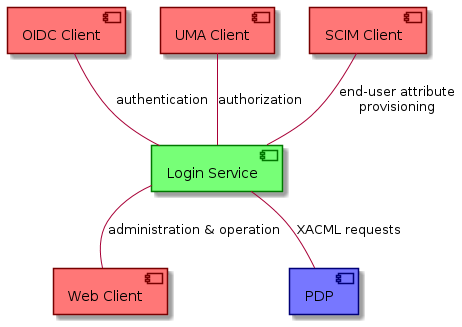
The EOEPCA Login Service provides implementations of the state-of-the-art standards and supports all building blocks that require authentication (through OIDC), authorization (through UMA) and user management capabilities (through SCIM). In addition to this, the Login Service exposes a Web Interface that can be used to perform monitoring and configuration management by operators.
The Login Service can also rely on XACML-based flows to verify access rights during an authorization flow, contacting mainly the XACML endpoints exposed by Policy Decision Point (PDP).
3.2.3. Provided Interfaces

The Login Service enables the following interfaces:
-
Administration Web Interface - Web Administration interface meant for Operators
-
OIDC Interface - OIDC compliant endpoint allowing acting as OpenID Provider (OP)
-
[mainUMA] - UMA compliant endpoints acting as Authorization Server (AS)
-
[mainSCIM] - SCIM compliant endpoints allowing User Management and user information retrieval mechanisms
3.2.3.1. Administration Web Interface
The Login Service provides administration functionality for users with elevated priviledges. This allows admins to have an overview of the entire system, as well as configure anything necessary from this interface.
This interface allows manual editing, creation and removal of OIDC Client configurations, UMA Scopes, Custom Polices and base configuration parameters.
3.2.3.1.1. Applicable Standards
No applicable standards besides Hypertext Transfer Protocol (HTTP) as means to serve the information to the End-User
3.2.3.1.2. Endpoints
URL(1): /
URL(2): /identity
By default, the Login Service administration portal resides on the root path of the deployment. This root path usually redirects to the management service located at:
3.2.3.2. OIDC Interface
The Login Service provides an OIDC compliant interface that allows Requesting Parties to authenticate End-Users through their use of credentials. It mainly acts as an identity layer on top of OAuth2.0
3.2.3.2.1. Applicable Standards
-
IETF - OpenID Connect 1.0
3.2.3.2.2. Endpoints
URL: /.well-known/openid-configuration
The Login Service exposes the standard discovery document, a JSON showcasing all the necessary metadata and endpoint enumeration for a client application to dynamically load all the needed endpoints.
3.2.3.3. UMA Interface
The Login Service provides a UMA compliant interface that allows Resource Servers (or Policy Enforcement Points running in front of these) to request valid Requesting Party Tokens (RPTs). UMA is a custom profile of OAuth2.0 that introduces a ticket-based profile, similar to the "authorization code" flow but keeping it agnostic in terms of authentication.
UMA mainly manages the notion of "resource" as the main managed object, with tickets being a representation of an attempt to access any given resource within a specific realm. In order to facilitate this, several resource management endpoints (registration, deletion, scope assignment) are made available and the standard intentionally leaves Policy resolution (access checks) out of the specification to facilitate integration with other technologies (XACML, and any given policy language).
3.2.3.3.1. Applicable Standards
-
Kantara Innitiative - UMA 2.0
3.2.3.3.2. Endpoints
URL: /.well-known/uma2-configuration
The Login Service exposes a dicovery document very much similar to OIDC well-known documents. Although this is not implicitly stated as necessary part of a UMA-compliant solution, serving a well-known endpoint makes client integration more familiar to developers that may be used to OIDC Client integration.
3.2.3.4. SCIM Interface
The Login Service provides a SCIM compliant interface, designed to make managing user identities in cloud-based applications and services easier due to its well-defined schemas and endpoints.
3.2.3.4.1. Applicable Standards
-
IETF RFC 7644 - System for Cross-domain Identity Management ~
3.2.3.4.2. Endpoints
URL: /.well-known/scim-configuration
Similarly to OIDC and UMA endpoints, this well-known endpoint allows to discover all relevant SCIM operations. Although this strategy is not enforced, serving a well-known endpoint makes client integration more familiar to developers that may be used to OIDC Client integration.
3.2.4. Required Interfaces
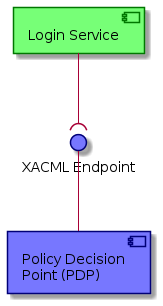
The Login Service utilizes the following interfaces:
-
[loginServiceXACML] - XACML compliant interface used to perform queries against a Policy Decision Point (PDP).
3.2.4.1. XACML Policy Checks
The Login Service might delegate policy checks, as part of its UMA workflow execution, to an external service that exposes an XACML-compliant interface (in this architecture, this could be provided by the Policy Decision Point). This standard mostly covers request and response format for a policy decision service, and includes a JSON binding that fully maps the original XML schemas to JSON schemas that can be used in XACML compliant request generation and response parsing.
3.2.4.1.1. Applicable Standards
-
OASIS - eXtensible Access Control Markup Language (XACML) Version 3.0 ~
-
OASIS (Public Draft) - JSON Profile of XACML 3.0 Version 1.1 ~
3.2.4.1.2. Remote Endpoints
URL: <pdp_instance>/policy/validate
Within EOEPCA, the remote endpoint stated above and exposed by the PDP will accept XACML compliant requests.
3.2.5. Example Scenarios
3.2.5.1. End-User Authentication
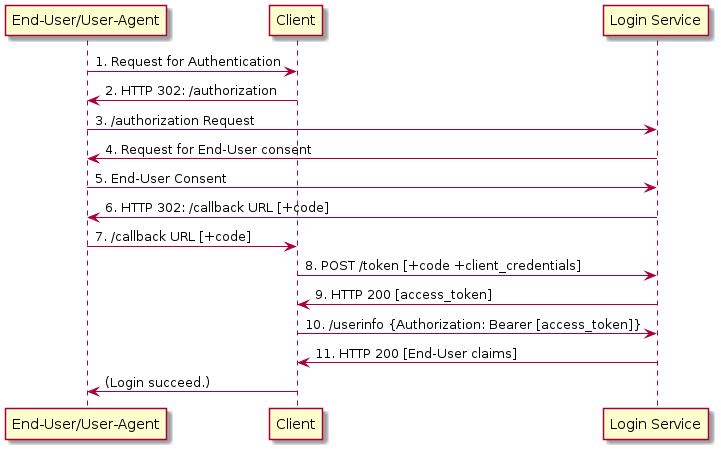
3.2.5.2. Resource Access
For an in detail scenario involving resource access, please refer to the Policy Enforcement Point section and its use of the UMA Endpoints
3.2.5.3. Identity Management
For an in detail scenario involving identity resource management, please refer to the Policy Decision Point section and its use of the SCIM Endpoints
3.3. Policy Enforcement Point (PEP)
Refer to PEP building block documentation - https://eoepca.github.io/um-pep-engine/master
3.3.1. Description
The Policy Enforcement Point (PEP) allows unsecured Resource Servers to be integrated in the architecture, by providing the means to securely register, manage and expose resources. Any Web Service provided by the architecture can potentially run an ad-hoc PEP service that serves as secure contact point and handles all the necessary UMA Flow steps.
3.3.2. Context
The following context diagram identifies the major components interfacing with the PEP:
(RED ~ consumers of PEP provided interfaces, BLUE ~ providers of interfaces consumed by the PEP)
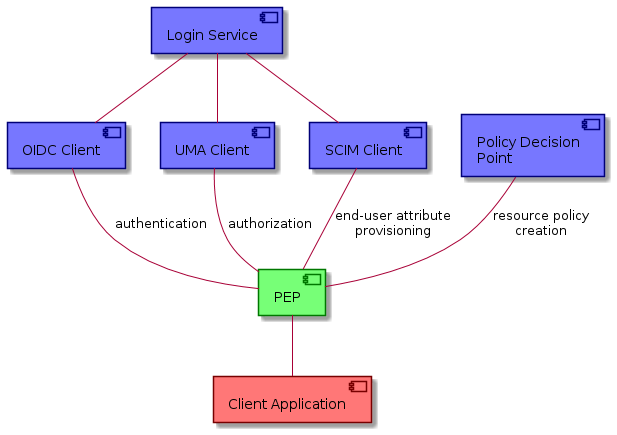
EOEPCA PEP Service provides a Platform Resource management API that abstracts the UMA Standard and facilitates its usage by Resource Owners. It also exposes unsecured endpoints of Resource Servers through its secure proxying endpoint.
The PEP relies on UMA to implement the necessary steps of the ticket-based authorization flow. It also allows propagation of End-User claims towards the Resource Server.
3.3.3. Provided Interfaces
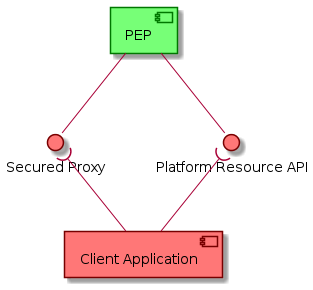
3.3.3.1. Platform Resource API
3.3.3.1.1. Applicable Standards
No applicable standards besides Hypertext Transfer Protocol (HTTP) and a RESTful API approach allowing CRUD operations over Resource reference objects.
3.3.3.1.2. Endpoints
URL: <um-pep-engine>:<resources_port>/resources/{id}
3.3.3.2. Secured Proxy
3.3.3.2.1. Applicable Standards
No applicable standards besides the capability to parse and enrich Hypertext Transfer Protocol (HTTP) operations .
3.3.3.2.2. Endpoints
URL: <um-pep-engine>:<proxy_port>/proxy/{back-end-url}
3.3.4. Required Interfaces

3.3.4.1. OIDC Authentication
The PEP utilizes an OIDC Client implementation to consume OIDC endpoints, authenticate itself as trusted platform component, generate JWT documents containing End-User information, and secure its Platform Resource API endpoints.
3.3.4.1.1. Applicable Standards
-
IETF - OpenID Connect 1.0
3.3.4.1.2. Remote Endpoints
URL: <um-login-service>/.well-known/openid-configuration
The Login Service exposes the standard discovery document, a JSON showcasing all the necessary metadata and endpoint enumeration for a client application to dynamically load all the needed endpoints.
3.3.4.2. UMA Authorization
The PEP utilizes a UMA Client implementation to consume UMA Endpoints, enforcing authorization of all requests made to the secure proxy endpoint (generation of tickets and RPT validation)
3.3.4.2.1. Applicable Standards
-
Kantara Innitiative - UMA 2.0
3.3.4.2.2. Remote Endpoints
URL: <um-login-service>/.well-known/uma2-configuration
The Login Service exposes a dicovery document very much similar to OIDC well-known documents. Although this is not implicitly stated as necessary part of a UMA-compliant solution, serving a well-known endpoint makes client integration more familiar to developers that may be used to OIDC Client integration.
3.3.4.3. Protected Resource Server
The PEP sits in front of a Resource Server and propagates all requests and responses (acting as an intermediate client). The only modifications performed by the PEP consist in the inclusion of an HTTP Header containing relevant End-User information.
3.3.4.3.1. Applicable Standards
No applicable standards besides the capability to parse and enrich Hypertext Transfer Protocol (HTTP) responses.
3.3.4.3.2. Remote Endpoints
The endpoint protected by the PEP is a configurable parameter and depends on the characteristics of the Resource Server running behing the PEP.
3.3.4.4. Policy Decision Point (PDP)
The PEP will interact with the PDP in order to assign a default access policy when registering a new resource.
3.3.4.4.1. Applicable Standards
No applicable standards besides the capability to parse and enrich Hypertext Transfer Protocol (HTTP) responses.
3.3.4.4.2. Remote Endpoints
URL: <um-pdp-engine>/policy
The endpoint name is configurable on the PDP side, with this being the default configuration.
3.3.5. Example Scenarios
3.3.5.1. Resource Access
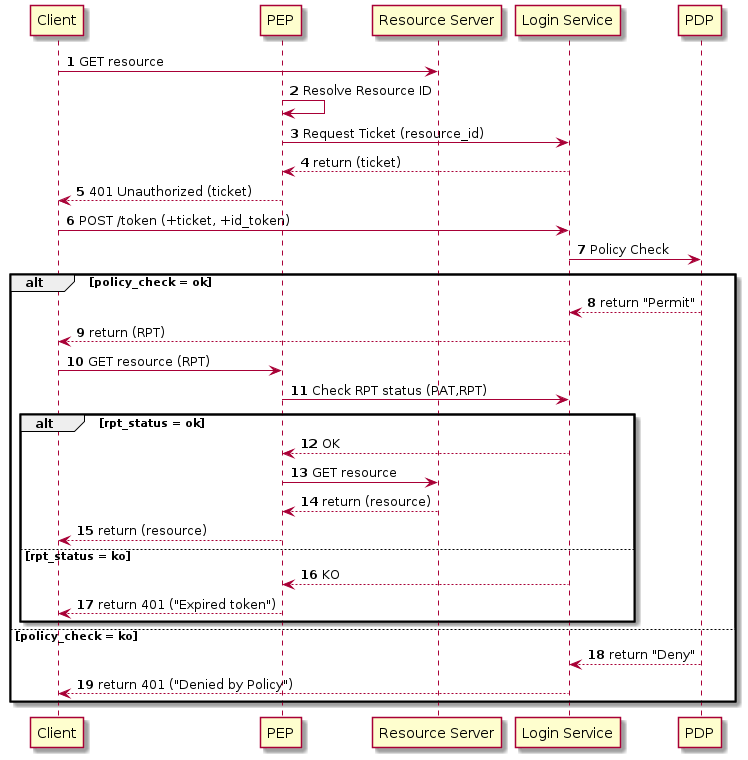
3.3.5.2. Resource Management

3.4. Policy Decision Point (PDP)
Refer to PDP building block documentation - https://eoepca.github.io/um-pdp-engine/master
3.4.1. Description
The Policy Decision Point (PDP) provides an XACML compliant decision endpoint that can be both consumed from entities which are external to the platform, and the components participanting in a UMA Flow (Login Service and PEP). It also allows to assign specific access policies to a resource.
3.4.2. Context
The following context diagram identifies the major components interfacing with the PDP:
(RED ~ consumers of PDP provided interfaces, BLUE ~ providers of interfaces consumed by the PDP)
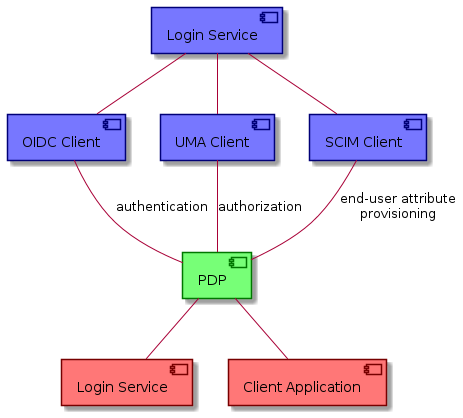
EOEPCA’s PDP Service interacts mainly with the Login Service to both consume its SCIM Endpoints (as source of End-User information) and serve an XACML compliant endpoint to support Policy-based Access Control. On the other hand, Client Applications used by Resource Owners can interact with the Policy Management API to manipulate the access contraints for any given resource.
3.4.3. Provided Interfaces

3.4.3.1. Platform Policy API
3.4.3.1.1. Applicable Standards
No applicable standards besides Hypertext Transfer Protocol (HTTP) and a RESTful API approach allowing CRUD operations over Resource reference objects.
3.4.3.1.2. Endpoints
URL: /policies/{id}
3.4.3.2. XACML Policy Checks
3.4.3.2.1. Applicable Standards
-
OASIS - eXtensible Access Control Markup Language (XACML) Version 3.0 ~
-
OASIS (Public Draft) - JSON Profile of XACML 3.0 Version 1.1 ~
3.4.3.2.2. Endpoints
URL: /policy/validate
This XACML Policy Check endpoint can potentially be available as a Platform interface, allowing external entities to perform policy checks when a Platform Resource is being consumed from outside of its Platform.
3.4.4. Required Interfaces
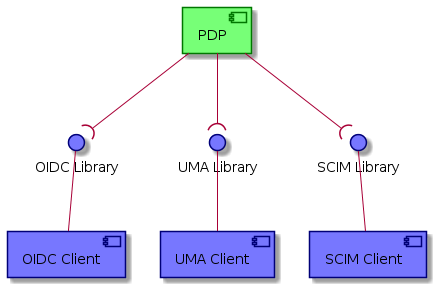
3.4.4.1. OIDC Authentication
The PDP utilizes an OIDC Client implementation to consume OIDC endpoints, and authenticate itself as trusted platform component, and secure its Policy API endpoints.
3.4.4.1.1. Applicable Standards
-
IETF - OpenID Connect 1.0
3.4.4.1.2. Remote Endpoints
URL: <um-login-service>/.well-known/openid-configuration
The Login Service exposes the standard discovery document, a JSON showcasing all the necessary metadata and endpoint enumeration for a client application to dynamically load all the needed endpoints.
3.4.4.2. UMA Authorization
The PDP utilizes a UMA Client implementation that allows to successfully access SCIM protected endpoints.
3.4.4.2.1. Applicable Standards
-
Kantara Innitiative - UMA 2.0
3.4.4.2.2. Remote Endpoints
URL: <um-login-service>/.well-known/uma2-configuration
The Login Service exposes a dicovery document very much similar to OIDC well-known documents. Although this is not implicitly stated as necessary part of a UMA-compliant solution, serving a well-known endpoint makes client integration more familiar to developers that may be used to OIDC Client integration.
3.4.4.3. SCIM Identity Management
The PDP utilizes an SCIM Client implementation that allows to retrieve information about End-Users and take it into account for its policy decision functionality
3.4.4.3.1. Applicable Standards
-
IETF RFC 7644 - System for Cross-domain Identity Management ~
3.4.4.3.2. Remote Endpoints
URL: <um-login-service>/.well-known/scim-configuration
Similarly to OIDC and UMA endpoints, this well-known endpoint allows to discover all relevant SCIM operations, allowing the PDP to dynamically load the list of endpoints to use.
3.4.5. Example Scenarios
3.4.5.1. Policy Access Check
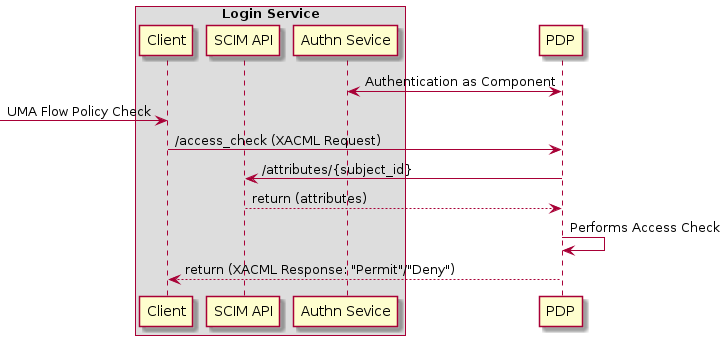
3.4.5.2. Policy Management
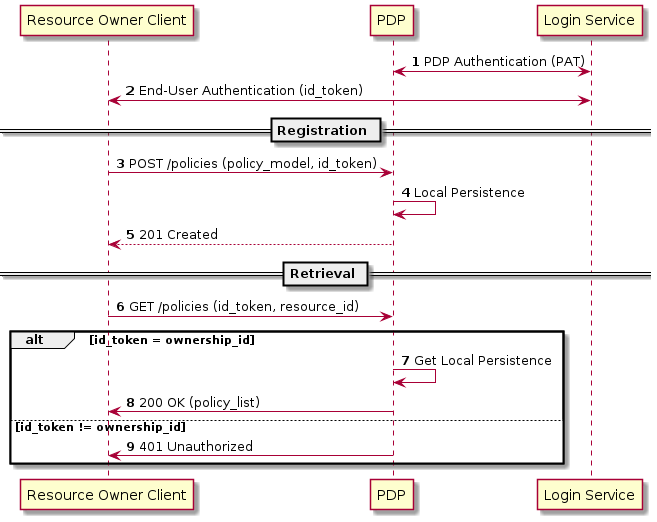
3.5. User Profile
Refer to User Profile building block documentation - https://eoepca.github.io/um-user-profile/master
3.5.1. Description
The User Profile building block serves to encapsulate profile actions (such as edit or removal) into a web interface, while at the same time providing the infrastructure upon which to implement other building blocks, such as Billing and Licensing.
3.5.2. Context
The following context diagram identifies the major components interfacing with the User Profile:
(RED ~ consumers of User Profile provided interfaces, BLUE ~ providers of interfaces consumed by the User Profile)
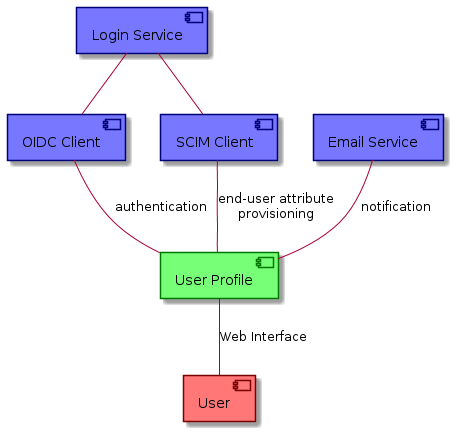
In order to support the Billing Service, the User Profile building block allows to identify users (leaving a reference to their home IdP), to assign them Billing Identities, Service API keys, License keys and to record Terms and Conditions acceptance. It’s a persistence service with interfaces that will be queried by other building blocks (License Manager, Billing Service, Policy Decision Point) and modified by both the License Manager and the Login Service (during creation of a new user profile or assignment of new Licenses).
3.5.3. Provided Interfaces
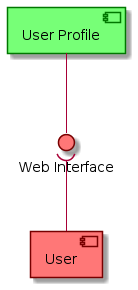
3.5.3.1. Profile Management Web Interface
A web service is made available for users to perform actions related to the building block, such as account removal.
3.5.3.1.1. Applicable Standards
No applicable standards besides Hypertext Transfer Protocol (HTTP) as means to serve the information to the End-User
3.5.3.1.2. Endpoints
URL: <um-login-service>/web_ui
3.5.4. Required Interfaces
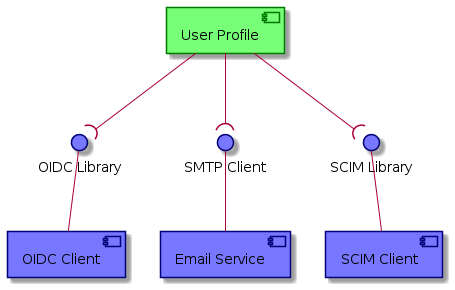
3.5.4.1. OIDC Authentication
The User Profile utilizes an OIDC Client implementation to consume OIDC endpoints, authenticate itself as trusted platform component, generate JWT documents containing End-User information, and secure its Platform Resource API endpoints.
3.5.4.1.1. Applicable Standards
-
IETF - OpenID Connect 1.0
3.5.4.1.2. Remote Endpoints
URL: <um-login-service>/.well-known/openid-configuration
The Login Service exposes the standard discovery document, a JSON showcasing all the necessary metadata and endpoint enumeration for a client application to dynamically load all the needed endpoints.
3.5.4.2. SCIM Identity Management
The User profile utilizes a SCIM Client implementation to consume SCIM endpoints, designed to make managing user identities in cloud-based applications and services easier due to its well-defined schemas and endpoints.
3.5.4.2.1. Applicable Standards
-
IETF RFC 7644 - System for Cross-domain Identity Management
3.5.4.2.2. Remote Endpoints
URL: /.well-known/scim-configuration
This well-known endpoint allows to discover all relevant SCIM operations. Although this strategy is not enforced, serving a well-known endpoint makes client integration more familiar to developers that may be used to OIDC Client integration.
3.5.4.3. Email Service
The User Profile building block also implements a SMTP Client, that allows for the sending of email notifications that serves as, and implements, a confirmation action in an account removal scenario.
3.5.4.3.1. Applicable Standards
-
IETF RFC 2822 - Internet Message Format
3.5.4.3.2. Remote Endpoints
URL: <um-login-service>/confirmation_mail
3.5.5. Example Scenarios
3.5.5.1. Attribute Edition
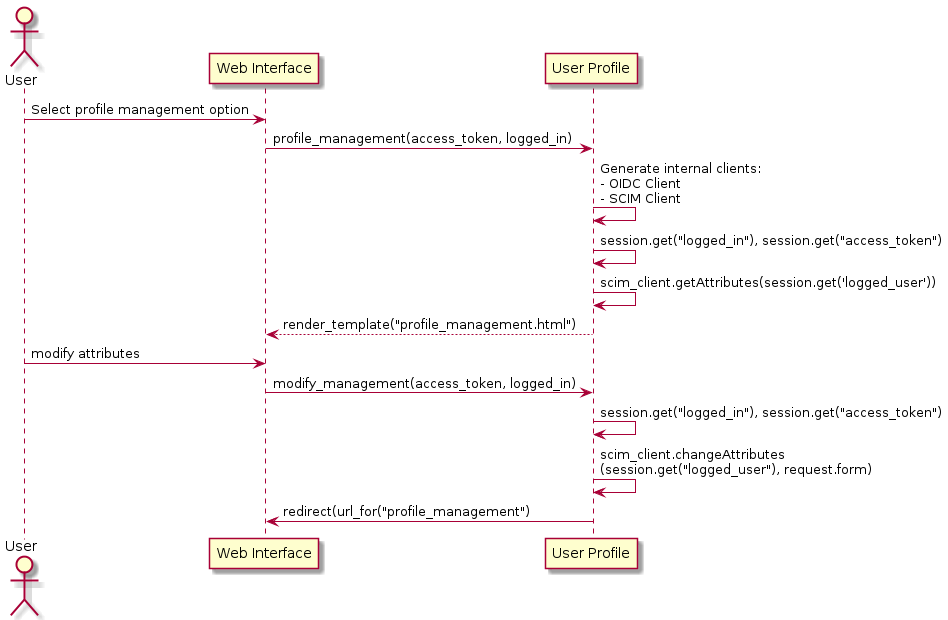
3.5.5.2. Account Deletion

3.6. License Manager
Not in the scope of Release 1.0
3.7. Billing Service
Not in the scope of Release 1.0
3.8. Pricing Engine
Not in the scope of Release 1.0
4. Processing & Chaining
4.1. Application Deployment and Execution Service (ADES)
Refer to ADES component documentation - https://eoepca.github.io/proc-ades/master
4.1.1. Description
The ADES provides processing services interfaces via WPS 1.0 & 2.0 service ports as well as an OGC API Processes compliant API. It is responsible for the execution of the processing service (as a WPS request) within the ‘target’ Exploitation Platform (i.e. one that is close to the data). In the global scenario, we assume that the EMS ensures that the processor is deployed as a WPS service before it is invoked.
4.1.2. Context
The following context diagram identifies the major components interfacing with the ADES:
(RED ~ consumers of ADES provided interfaces, BLUE ~ providers of interfaces consumed by the ADES)
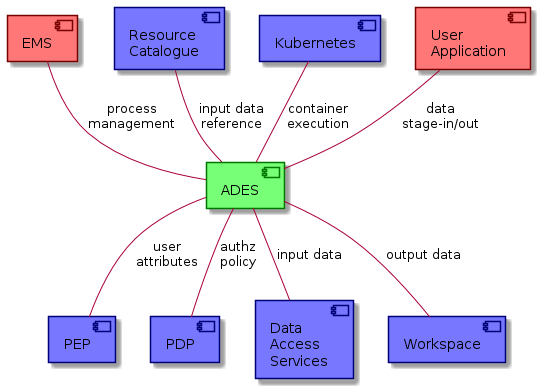
The EOEPCA Execution Management Service (EMS) is the main client of the ADES that (un)deploys applications, executes & monitor jobs.
All interactions with the ADES should be via the Policy Enforcement Point (PEP) that filters authorized requests, and provides user attributes to the ADES, allowing the user’s context to be propagated through onward requests. The ADES obtains authorization policy information, as required, from the policy endpoint of the Policy Decision Point (PDP).
The ADES resolves input data references via the Resource Catalogue, with the data retrieved through the Data Access Services referenced by the catalogue. The ADES interfaces with the User Application to orchestrate its execution (incl. data stage-in/out). The ADES interfaces to the Kubernetes cluster for execution of the requested application. Processing outputs are persisted to the Workspace.
4.1.3. Provided Interfaces
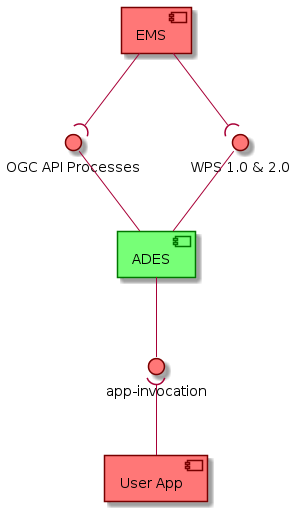
The ADES enables interfaces for the processing based on the OGC "Web Processing Service". It exposes 2 web services:
-
Web services for processing:
-
WPS 1.0.0 & 2.0.0 - OGC Web Services Common [OGC-COMMON] hosting WPS 1.0.0 & 2.0.0 processing services
-
OGC API Processes - OGC API Processes [OGC-API-PROC] hosting WPS in RESTful core OpenAPI
-
-
Application Invocation - the ADES establishes standard conventions with the application being invoked, through which the application receives its inputs and provides its outputs
4.1.3.1. WPS 1.0.0 & 2.0.0
The OpenGIS® Web Processing Service (WPS) Interface Standard provides rules for standardizing how inputs and outputs (requests and responses) for geospatial processing services, such as polygon overlay. The standard also defines how a client can request the execution of a process, and how the output from the process is handled. It defines an interface that facilitates the publishing of geospatial processes and clients’ discovery of and binding to those processes. The data required by the WPS can be delivered across a network or they can be available at the server.
4.1.3.1.1. Applicable Standards
-
OGC Web Processing Service 1.0 - [OGC-WPS]
-
OGC Web Processing Service 2.0 - [OGC-WPS2]
4.1.3.1.2. Endpoints
The WPS server is self-contained, it provides an initial endpoint that can be used by a WPS client to determine the server’s capabilities. GET, POST operations according to the payload of the requested service, with bindings defined for HTTP/POST+XML and HTTP/GET+KVP.
Standard Operations
Examples with HTTP/GET+KVP binding…
- GetCapabilities
-
http://hostname:port/path?service=WPS&request=GetCapabilities
Allows a client to retrieve service metadata, basic process offerings, and the available processes present on a WPS server - DescribeProcess
-
http://hostname:port/path?service=WPS&version=2.0.0&request=DescribeProcess&identifier=ALL
Allows WPS clients to query detailed process descriptions for the process offerings - GetStatus
-
http://hostname:port/path?service=WPS&version=2.0.0&request=GetStatus&jobid=FB6DD4B0-A2BB-11E3-A5E2-0800200C9A66
Allows WPS clients to query the status of an asynchronously executed job - GetResult
-
http://hostname:port/path?service=WPS&version=2.0.0&request=GetResult&jobid=FB6DD4B0-A2BB-11E3-A5E2-0800200C9A66
Allows WPS clients to query the result of a finished processing job
Only HTTP/POST+XML binding for execute…
- Execute
-
http://hostname:port/path?service=WPS+ XML POST data
Allows WPS clients to run a specified process implemented by a server
EOEPCA Extension Operations
- DeployProcess
-
Executeoperation with a process identifier ofeoepcaadesdeployprocess
Allows a client to deploy a custom process to be made available via the WPS service - UndeployProcess
-
Executeoperation with a process identifier ofeoepcaadesundeployprocess
Allows a client to undeploy a previously deployed custom WPS process
| The 2 previously described processes implement the transactional function of the WPS known at WPS-T in WPS 1.0 & 2.0. In the OGC API Processes described in the next section, those functions are embedded as HTTP methods (POST & DELETE) at process level. |
4.1.3.2. OGC API Processes
The OGC API - Processes enables the execution of computing processes and the retrieval of metadata describing their purpose and functionality. Typically, these processes combine raster, vector, and/or coverage data with well-defined algorithms to produce new raster, vector, and/or coverage information.
4.1.3.2.1. Applicable Standards
-
OGC API - Processes ~ [OGC-API-PROC]
4.1.3.2.2. Endpoints
Standard Operations
| Resource | Method | Description | Operation |
|---|---|---|---|
|
GET |
landing page of this API |
|
|
GET |
Lists all requirements classes specified in the standard (e.g., OGC API - Processes Part 1: Core) that the server conforms to |
|
|
GET |
Lists all available processes this server offers. |
|
|
GET |
Describes a process. |
|
|
GET |
Lists available jobs of a process. |
|
|
POST |
Submits a new job. |
|
|
GET |
Shows the status of a job. |
|
|
DELETE |
Cancel a job execution and remove it from the jobs list. |
|
|
GET |
Lists available results of a job. In case of a failure, lists exceptions instead. |
Transactional Extension
| Resource | Method | Description | Operation |
|---|---|---|---|
|
POST |
Allows a client to deploy a custom process to be made available via the Processing service |
DeployProcess |
|
DELETE |
Allows a client to undeploy a previously deployed custom process |
UndeployProcess |
4.1.3.3. Application Invocation
4.1.3.3.1. CWL as Application Descriptor
CWL is used as the application package descriptor. It covers the following elements necessary to describe the application:
-
Workflow directed acyclic graph orchestrating the steps in order mapping workflow input/output with steps input/output
-
Steps describing a command line with their input/output
-
CWL specification extensions that may be used to provide the additional information elements
The application package is thus composed of a CWL file with the role of the application descriptor.
The container reference is included in the CWL as a requirement.
4.1.3.3.2. Application Deployment to Web Processing Service
The ADES offers an entry point to deploy the application package (see previous sections).
Regardless of the deployment mechanism, the CWL is used to convey the information to describe the web service inputs/outputs using WPS concepts.
The mapping between CWL and WPS follows the rules described in the following sections.
The workflow level is the entry point to the workflow and thus the interface used to map the inputs/outputs.
The inputs/outputs description defined in the command line or workflow steps are not taken into account directly since they are inked between steps or bound at workflow level as foreseen by the CWL specification.
Indeed, at the web processing service level, only the “staged” input and output parameters are exposed.
4.1.3.3.3. CWL staged (in/out) files
File or Directory are CWL parameters types corresponding to files on a file system and thus require a specific mapping according to the implementation of the software component exposing the WPS.
Indeed, the software component executing the processes must manage physical files in the processing environment. At job submission, physical files may be a reference to a resource manager and the software component fetches them to make them available for processing as specified in the CWL using File or Directory type.
Therefore, the following mapping rules integrate the resource reference management capabilities.
This is the type(s) of reference to a physical resource that the software component manages. For instance: HTTP link, S3 link, opensearch URL, STAC catalog, etc.
The interface for the execution process must have a STAC local catalog (catalog.json and all downstream files: collection.json, items and assets including their associated files) referencing all the data staged-in corresponding collections as specified initially in the CWL.
In the above example, the CWL describes a File in input. The parameter is extended with stac:catalog that defines the collection in which the “staged” data must be referenced to.
A detailed example is described in section CWL data staging.
-
CWL File mandatory parameter example *
In this example, we assume the software component is able to handle the following resource description document or references:
-
Opensearch description document describing possible search endpoints to find input files
-
Atom feed with entries containing the input files (enclosures)
-
STAC catalogue with features describing assets as input files
| Resource |
|---|
CWL |
|
WPS 1.0 |
|
WPS 2.0.2 |
|
OGC API Processes (JSON) |
|
CWL data referencing mechanism manages File and Directory data types
catalog.json |
|
collection-input_file.json |
|
The complete example at the end of this section describes in details how data are staged in and STAC catalogs generated.
4.1.4. Required Interfaces
The ADES communicates to other components through the interfaces described in this section.
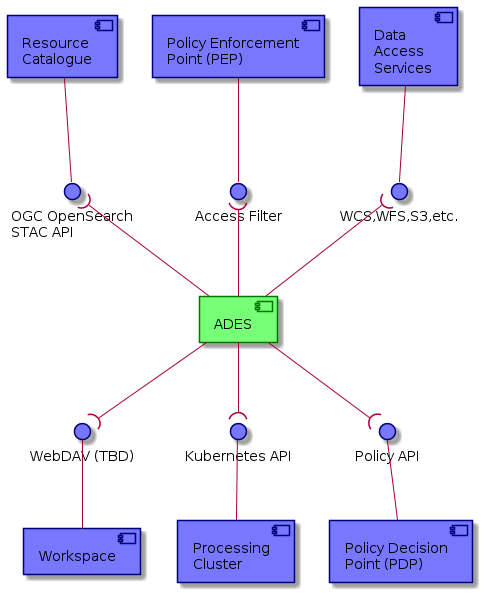
4.1.4.1. Resource Managers
4.1.4.1.1. Catalogue for referenced data
Since all data (resources) for processing are passed (in or out) by reference, the ADES must be able to contact those resources' manager (e.g. catalog).
In input, the ADES supports both OpenSearch ([CEOS-OS-BP]), [STAC-SPEC] and [STAC API] as resources protocols.
In output, the ADES supports the transactional functions of the [STAC API] to publish catalogs.
4.1.4.1.2. Data Access Services for data stage-in
The referenced assets in the catalogs (see previous section) are accessible from the same or another resource manager. Their enclosure URL allows to download entirely the asset or to access parts or it (e.g. COGs with HTTP range).
The ADES supports the following protocols:
- HTTP download
- S3 Download
- WebDAV upload
4.1.4.1.3. Cluster infrastructure for processing execution
The ADES uses a kubernestes API for deploying its services and to provision resources for processing.
4.1.5. Example Scenarios
This section provides examples of the ADES interfacing flows.
4.1.5.1. ADES Processing Flows
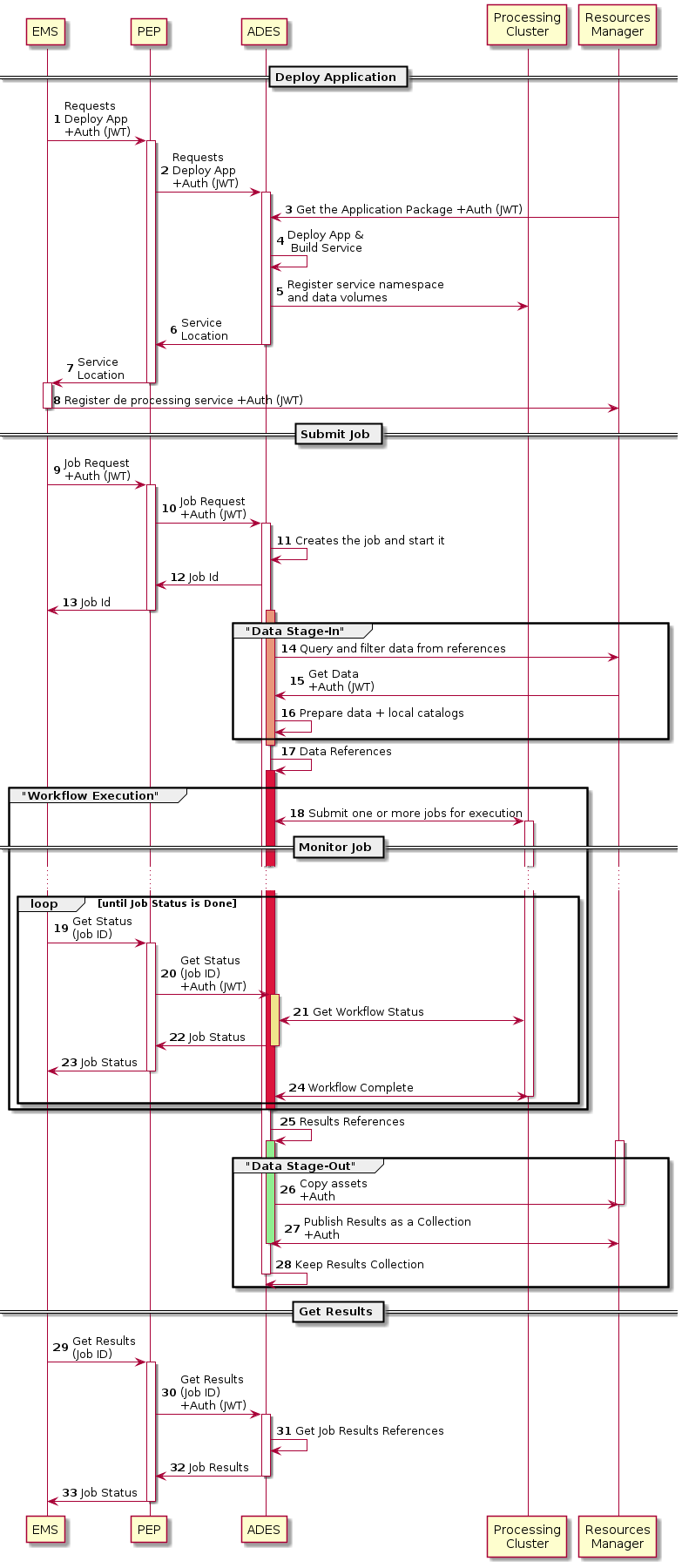
Deploy Application
The first sequence is the application deployment. In the EOEPCA scenario, this is initiated by the EMS that uses the transactional functions of the ADES.
-
The EMS invoke a service or POST a request to the ADES with the reference to an Application Package and pass by the PEP that allows the deployment accoring to the policy
-
The request is transferred to the ADES along with an auth token
-
The ADES gets the Application Package referenced in the deployment request
-
The ADES registers internally the application as a service
-
The ADES sets a namespace for the service and data volume if necessary
-
The ADES returns the service location to the PEP
-
The PEP returns the service location to the EMS
-
The EMS registers the service deployed on the ADES on the catalog
Submit Job
The second sequence is the service invokation via a job submission.
-
The EMS makes a job request to the ADES via the PEP
-
The PEP authorizes and transfer the request to the ADES
-
The ADES instantiates the job and returns the job identifier
-
The ADES returns the job id to the PEP
-
The PEP returns the job id to the EMS
Data Stage-In
The first stage is about how the ADES prepares the data for the processing. This is a pre-processing step that must provision all the data needed for processing and referenced in the job execute request.
-
The ADES queries the data references passed as input of the job reequest to the resource manager (e.g. catalog)
-
With the results of the previous request, the ADES retrieves all the assets requested from the resource manager (e.g. data store)
-
The ADES organizes and prepare the data as nedded (e.g. unzip) and rebuild the catalog to point to locally copied data
-
The data references are passed to the next stage of the execution
Workflow Execution
Data is now ready to be processed by the main processing. The software component will ensure that the input data folder will be properly mounted on each cluster node and accessible from the container that executes the processing. This is the main stage where the processing is actually executed on the data.
-
The ADES submits and coordinates the necessary jobs as defined in the application workflow
Monitor Job
This sequence in a parallel sequence triggered by the EMS each time it requests for the job status during the asynchronous job execution
-
EMS makes a request for status with the Job Id previously returned (13) via the PEP
-
PEP passes the requests along
-
The ADES builds a job progress report based on the workflow execution status
-
The ADES returns the job status document via the PEP
-
The PEP returns the job status to the EMS
-
Once the job is completed, the job status reports the job results location
-
The results refertences are passed to next stage
Data Stage-Out
The last stage is about how the ADES publishes the data after the processing. This is a post-processing step that must copy the selected data to a persistent storage and registers theit reference to a catalog for further searches.
-
The ADES copies the results' assets to the persistent storage of the resource manager (e.g. WebDAV)
-
Publish a collection of the assets produced with the reference to the persistent storage to the catalog
-
Keep in the cache of the ADES a reference to the collection for further results query
Get Results
This ending sequence is the results report from the ADES
-
EMS makes a request for results with the Job Id previously returned (13) via the PEP
-
PEP passes the requests along
-
The ADES builds a results report based on the results collection (28)
-
The ADES returns the job results document via the PEP
-
The PEP returns the job results to the EMS
4.2. Execution Management Service (EMS)
TBD
4.3. Workflow Engine
TBD
4.4. Processor Development Environment (PDE)
TBD
4.5. Interactive Analysis Tool (IAT)
TBD
5. Resource Management
5.1. Resource Catalogue
TBD
5.2. Data Access Services
TBD
5.3. Data Access Gateway
TBD
5.4. Data Access Library
TBD
5.5. Data Ingestion
TBD
5.6. Workspace
TBD
<< End of Document >>